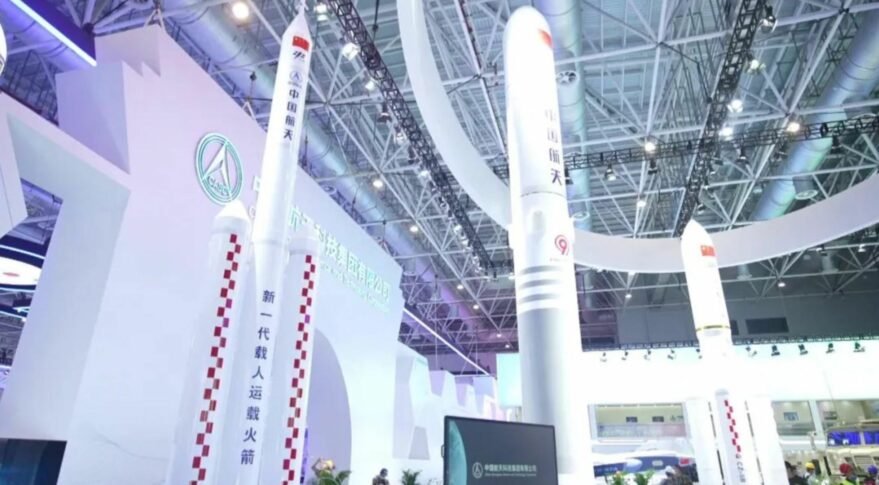
New models of the Long March 9 (center) and Long March 5G crew launcher (left) at the Zhuhai Airshow 2022. Credit: OurSpace
By Andrew Jones,
Published by SpaceNews, 9 November 2022
HELSINKI — Rocket designers with China’s main launch vehicle institute have scrapped plans for an expendable super heavy-lift launcher in favor of a design featuring a reusable first stage.
A new model of a Long March 9 rocket featuring grid fins and no side boosters recently went on display at the ongoing Zhuhai Airshow in southern China, prompting speculation that the long-standing plan of an expendable rocket had been dropped.
Liu Bing, director of the general design department at the China Academy of Launch Vehicle Technology (CALT), later confirmed the new direction in an interview with China Central Television Nov. 7.
The new, current plan for the rocket will be a three-stage, 108-meter-high, 10-meter-diameter and 4,180 metric ton rocket capable of delivering 150 tons to low Earth orbit (LEO), 50 tons to lunar transfer orbit (LTO), or 35 tons to Mars transfer orbit. The rocket is scheduled to be ready for test flight around 2030.

Liu told CCTV however that the design has not been finalized and will likely see changes as the team selects the optimal pathway, while committing to the goal of constantly breaking through technological challenges and increasing its launching power.
The Long March 9 rocket project has been under development at CALT for a number of years. The original plan was to build an expendable rocket capable of delivering 100 metric tons or more to LEO.
The original design would have made the Long March 9 analogous to NASA’s Space Launch System (SLS), the first of which, for the Artemis 1 mission, currently sits on the pad at Launch Complex 39B at the the Kennedy Space Center with Tropical Storm Nicole approaching Florida.
In recent years senior CALT official Long Lehao has presented new concepts for the Long March 9, apparently in reaction to developments in reusability demonstrated by SpaceX.
The presentations suggested, unofficially, at a transition away from the expendable version with boosters, displayed at Zhuhai Airshow last year, to separate reusable kerosene (sometimes referred to as version 21 and version 22) and methane-fueled concepts. The methane version could be ready by 2035, according to Long.
The new model keeps the old timeframe for a test flight, suggesting a switch from large, dual-nozzle 500-ton-thrust engines, to clusters of lower thrust, single-nozzle engines noted in Long’s presentations to facilitate recovery and reuse.
At the same time, the Sixth Academy of the China Aerospace Science and Technology Corporation (CASC), which also owns CALT, recently performed the first full system hot fire test of the 500-ton-thrust YF-130 kerosene-liquid oxygen engine, thought to be developed to power the expendable Long March 9. How the engine will be used going forward remains to be seen.
Also on display in Zhuhai was China’s new generation crew launch vehicle, sometimes referred to as the Long March 5 Dengyue (“moon landing”) or Long March 5G. The showing indicates a shift from the slanted nose cones on the side cores of earlier models.
The rocket will be capable of sending 27 metric tons into trans-lunar injection. A pair of the new rockets will be capable of sending a crewed spacecraft and, separately, a landing stack, to lunar orbit. This would allow two astronauts to make a landing on the moon.
Liu said the rocket is almost ready for the prototyping stage and would have a test flight in 2027. It was not clear if this referred to the single-stick variant for launches of a new generation crew spacecraft to LEO—earlier slated for a 2026 first launch—or the full, three-core, three-stage version for lunar missions.
CASC recently conducted 300-second mission duty cycle tests of the YF-100M vacuum-optimized engines for the rocket’s second stage.
Senior Chinese space officials including Long Lehao and Ye Peijian stated last year the country will be capable of executing this idea for the two-launch, short-term lunar stay mission before 2030.
See: Original Article





